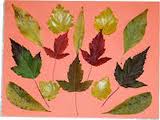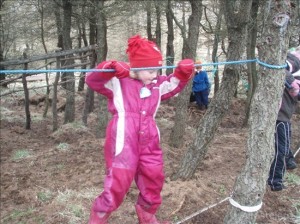The following activities can take place in a woodland. Each activity can be adapted to the children’s age, interest and ability. These are just a few of the many activities that children can enjoy and learn from during their time in the woodland area.
Activity 1 – This activity should take place indoors before going to the outdoor area. It should be the first activity before beginning any outdoor session. Gather the children together and discuss how the weather is, and what clothes they should put on to go outside. Spend time explaining the importance of clothing, for staying cool, warm, dry and so on. Remember there is no bad weather only bad clothes.
 Activity 2 – With a stick or finger each child can write their name or draw a picture in the ground. In the summer the children can write their name in the mud and in the winter they can write their name in the snow.
Activity 2 – With a stick or finger each child can write their name or draw a picture in the ground. In the summer the children can write their name in the mud and in the winter they can write their name in the snow.
 Activity 3 – This activity can be done with all aged child and varied slightly to appeal to all ages. The children lie down or sit against a tree facing various directions and discuss what the can see from their view point. This activity will help to increase the children’s vocabulary, attention and visual awareness. Older children can be asked to discuss not only the names of what they can see, but also the colours, amounts and shapes of the objects.
Activity 3 – This activity can be done with all aged child and varied slightly to appeal to all ages. The children lie down or sit against a tree facing various directions and discuss what the can see from their view point. This activity will help to increase the children’s vocabulary, attention and visual awareness. Older children can be asked to discuss not only the names of what they can see, but also the colours, amounts and shapes of the objects.
A similar activity focuses on listening skills, rather than visual skills. The children lay or sit down and close their eyes. They are asked to listen to the sounds around them. The teacher then gathers the children together, and they discuss the kind of noises they heard and what they think made the noise.
 Activity 4 – Children are curious about the world around them. This could be encouraged by giving the children magnifying glasses for a closer look at the forest. Allow the children time to explore with the magnifying glasses, interesting places to look are trees, fallen branches, leaves, insects and under rocks. After enough time to discover the forest closer, the children should gather in a circle and discuss what they found that interested them.
Activity 4 – Children are curious about the world around them. This could be encouraged by giving the children magnifying glasses for a closer look at the forest. Allow the children time to explore with the magnifying glasses, interesting places to look are trees, fallen branches, leaves, insects and under rocks. After enough time to discover the forest closer, the children should gather in a circle and discuss what they found that interested them.
Activity 5 – This activity is designed for older children (4 years +), however with a few adjustments it can also be suitable for younger children. The activity involves the children walking along a nature trail in the woodland, blindfolded. There are a number of methods to carry out this activity. The first method and the one that is more suitable for younger children, is to create a nature trail around the woodland using a rope. The children are blindfolded (young children or those that find it uncomfortable to be blindfolded, should be allowed to walk along the trail without the use of a blindfold), and they all hold on to the rope and walk slowly. The teacher calls out stop at various points, indicating for the children to reach out and touch, smell or listen to something of interest.
The second method more suitable for the older children, involves the children working together in pairs. The aim behind this activity is to encourage trust and strong bonds between the children. One child is blindfolded while the other will act as the guide. The guide has to direct the blindfolded child along the trail by giving commands such as, walk forward, stop, and step down and so on. Once the pair has made it through the trail the guide changes places with the blindfolded child.
 Activity 6 – Gather the children in a circle with their eyes closed. Pass an object to each child, such as a stick, leaf, stone, or pine cone, and ask them to feel it or smell it. Give the children time to do this before asking them what they think their object is.
Activity 6 – Gather the children in a circle with their eyes closed. Pass an object to each child, such as a stick, leaf, stone, or pine cone, and ask them to feel it or smell it. Give the children time to do this before asking them what they think their object is.
Activity 7 – Read a story and sing songs sitting under a tree or on a circle of logs. The stories and songs could be related to the woodland, e.g trees, animals or woodland fairies The children could also be given the opportunity to tell their own story.
 Activity 8 – Give each child a basket and ask them to collect any objects in the woodland they find interesting. With the objects the children can create collages and pictures to be displayed on the preschool wall.
Activity 8 – Give each child a basket and ask them to collect any objects in the woodland they find interesting. With the objects the children can create collages and pictures to be displayed on the preschool wall.

